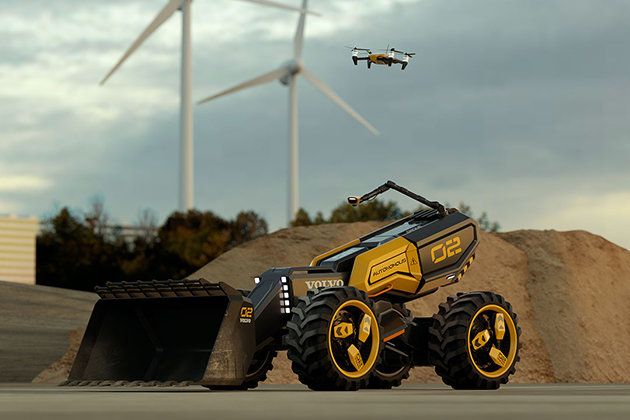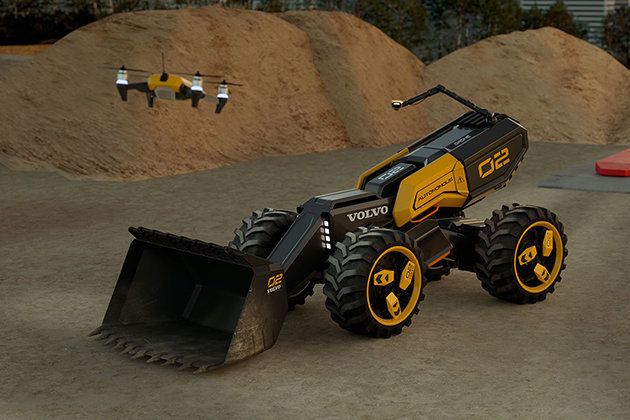We hear a lot about the future of transport, whether it’s self-driving cars, transcontinental bullet trains or sub-orbital aircraft, but the future of construction vehicles is not something many of us spend much time thinking about. Not so Volvo Construction Equipment and LEGO Technic, who have teamed up these past few years to ponder exactly this.
What’s more, when they invited a group of children to take part in the discussion as part of a fun team-building event, so innovative and surprising were the results that LEGO created the resulting vehicle as a Technic set, due to be released this August.
This model may seem futuristic now, but autonomous, connected and electric construction machines are a reality. The Volvo Concept Wheel Loader ZEUX is the next step in this journey.
The kids are all right
The collaboration between LEGO Technic and Volvo CE is a curious one when you consider the enormous differences in their markets, but as Volvo’s Arvid Rinaldo points out, “It allowed us to test ideas for new types of construction machines, both in terms of functionality, scale, design and interaction.”
Even the biggest forms of construction need models in the experimental stage, and few companies know models better than LEGO.
The resulting LEGO Technic Volvo Concept Wheel Loader ZEUX is what’s known as an autonomous construction machine. In many respects it’s recognisable as the kind of vehicle seen on construction sites the world over, what with it’s large bucket at the front for scooping up soil and rubble, and its fat, tractor-style wheels. What’s missing is the cabin in the centre of the vehicle where the driver would sit.
But things get even more interesting with the decision to bring in a focus group of children to offer feedback on the early drawings and models. This has led to the development of two new and unique features on this autonomous construction vehicle – a scout drone and an adjustable ‘camera’ boom mounted on the roof of the vehicle, called the ‘Eye’.

Eye robot
The Eye is designed as a safety feature to show exactly where the vehicle’s attention is directed, since on a construction site workers are used to being able to communicate visually or otherwise with whoever is driving a vehicle and thus make them aware of their presence.
“It’s not intuitive for us to decode what the autonomous vehicle’s next move is, where it’s going or if it’s seen us,” says Andrew Woodman, Senior Design Manager for LEGO Technic. “So we set out to create features and functions that make the interaction between humans and machines as safe and intuitive as possible.”
As for the ‘Scout’ drone, this is a quadcopter that nestles in a submerged launch pad at the rear of the vehicle. It’s designed to map the immediate area of the construction site from above, so the ZEUX can determine where it’s needed next and what the challenges of the terrain might be.
Putting to one side the practical application, it also looks really cool. And the ZEUX includes other innovations, such as four-wheel steering and a chassis that raises and lowers to enable the vehicle to negotiate more uneven terrain. “This may seem futuristic now,” says Rinaldo, “but autonomous, connected and electric construction machines are already starting to be a reality.

Kindred spirits
Through workshops, video meetings and brainstorming sessions, designers, engineers and quick-thinking kids have created a vehicle that will emerge in a few years as a full size concept at Volvo. As far as Woodman is concerned, it reveals a kindred spirit between the two companies. “Volvo CE and the LEGO Group share the same values when it comes to our requirements for quality and usability, while at the same time pushing the boundaries of creativity and functionality.”
Expect those boundaries to be pushed further, with automated construction machines running on renewable energy and connected to a ‘smart city’ grid, enabling them to converge on sites where they’re needed most, never sitting idle in one place when they could be proving useful somewhere else.
But whatever the future of the industry, LEGO and Volvo both know that their greatest resource lies in the enthusiastic kids destined to become the designers and engineers of tomorrow.